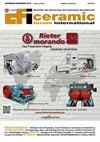Characterization and modelling of structure and transport properties of porous ceramics
Q4 Materials Science
引用次数: 6
Abstract
It is well known, that ceramics having a wide scale of porous morphologies are used in many different applications such as bio-ceramics, chemical engineering, exhaust gas treatment, fi ltration etc. [1, 2]. Porous systems ranging from an entirely open pore network e.g. for catalyst supports to entirely closed pore structures e.g. for insulation materials exist. The application of such porous ceramic systems is quite often connected to specifi c transport properties, e.g. fl ow of media in fi ltration, ion conductivity in electrochemical membranes or thermal conductivity in insulation materials. All these transport properties are known for bulk and dense materials but in case of biphasic materials (bulk and pores) such properties could be calculated only if the geometry of the biphasic material is known in detail. On the other hand, ceramic engineering methods provide different routes to tailor porosity and microstructure to a certain degree. Typical methods to produce and to adjust porosity are partial sintering, use of pore formers or templates, foaming, freezing or size exclusion of particles. Typical development schemes involve preparation of sets of samples and measurement of the resulting properties. By optimisation strategies, sometimes supported by “design of experiment” methodologies, the target properties can be reached. By employing a strategy of model generation and virtual material testing this process might be signifi cantly optimised. Fig. 1 shows a general scheme of development cycles, which involve different stages of Characterization and Modelling of Structure and Transport Properties of Porous Ceramics多孔陶瓷结构与输运特性的表征与建模
众所周知,陶瓷具有广泛的多孔形态,用于许多不同的应用,如生物陶瓷、化学工程、废气处理、过滤等[1,2]。存在从完全开放的孔隙网络(例如用于催化剂支架)到完全封闭的孔隙结构(例如用于绝缘材料)的多孔系统。这种多孔陶瓷系统的应用通常与特定的传输特性有关,例如过滤中的介质流动,电化学膜中的离子导电性或绝缘材料中的导热性。对于块状和致密材料,所有这些输运性质都是已知的,但对于双相材料(块状和孔隙),只有在详细知道双相材料的几何形状时,才能计算出这些性质。另一方面,陶瓷工程方法为在一定程度上定制孔隙度和微观结构提供了不同的途径。产生和调节孔隙率的典型方法是部分烧结,使用孔隙形成剂或模板,发泡,冷冻或颗粒尺寸排除。典型的开发方案包括制备样品集和测量所得性质。通过优化策略,有时由“实验设计”方法支持,可以达到目标属性。通过采用模型生成和虚拟材料测试的策略,这一过程可能会显着优化。图1显示了开发周期的总体方案,其中涉及多孔陶瓷结构和输运特性的表征和建模的不同阶段
本文章由计算机程序翻译,如有差异,请以英文原文为准。
求助全文
约1分钟内获得全文
求助全文

 求助内容:
求助内容: 应助结果提醒方式:
应助结果提醒方式:


